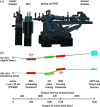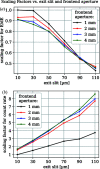The meV XUV-RIXS facility at UE112-PGM1 of BESSY II
- PMID: 35511024
- PMCID: PMC9070711
- DOI: 10.1107/S1600577522003551
The meV XUV-RIXS facility at UE112-PGM1 of BESSY II
Abstract
Resonant inelastic X-ray scattering in the XUV-regime has been implemented at BESSY II, pushing for a few-meV bandwidth in inelastic X-ray scattering at transition metal M-edges, rare earth N-edges and the K-edges of light elements up to carbon with full polarization control. The new dedicated low-energy beamline UE112-PGM1 has been designed to provide 1 µm vertical and 20 µm horizontal beam dimensions that serve together with sub-micrometre solid-state sample positioning as the source point for a high-resolution plane grating spectrometer and a high-transmission Rowland spectrometer for rapid overview spectra. The design and commissioning results of the beamline and high-resolution spectrometer are presented. Helium autoionization spectra demonstrate a resolving power of the beamline better than 10 000 at 64 eV with a 300 lines mm-1 grating while the measured resolving power of the spectrometer in the relevant energy range is 3000 to 6000.
Keywords: BESSY II; X-ray photoelectron spectroscopy; XUV; resonant inelastic X-ray scattering; soft X-ray spectroscopy.
open access.
Figures









References
-
- Ament, L. J. P., van Veenendaal, M., Devereaux, T. P., Hill, J. P. & van den Brink, J. (2011). Rev. Mod. Phys. 83, 705–767.
-
- Bahrdt, J., Follath, R., Frentrup, W., Gaupp, A., Scheer, M., Garrett, R., Gentle, I., Nugent, K. & Wilkins, S. (2010). AIP Conf. Proc. 1234, 335–338.
-
- Baumgärtel, P., Grundmann, P., Zeschke, T., Erko, A., Viefhaus, J., Schäfers, F. & Schirmacher, H. (2019). AIP Conf. Proc. 2054, 060034.
-
- Baumgärtel, P., Witt, M., Baensch, J., Fabarius, M., Erko, A., Schäfers, F. & Schirmacher, H. (2016). AIP Conf. Proc. 1741, 040016.
-
- Chiuzbăian, S. G., Schmitt, T., Matsubara, M., Kotani, A., Ghiringhelli, G., Dallera, C., Tagliaferri, A., Braicovich, L., Scagnoli, V., Brookes, N. B., Staub, U. & Patthey, L. (2008). Phys. Rev. B, 78, 245102.
LinkOut - more resources
Full Text Sources
Miscellaneous

